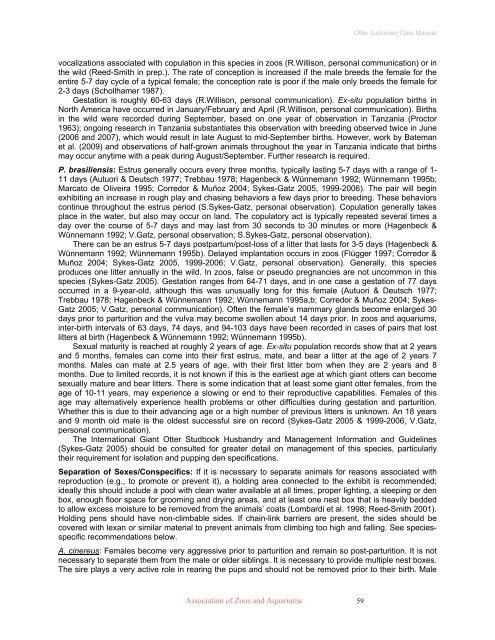Otter (Lutrinae) Care Manual - Association of Zoos and Aquariums
Otter (Lutrinae) Care Manual - Association of Zoos and Aquariums
Otter (Lutrinae) Care Manual - Association of Zoos and Aquariums
Create successful ePaper yourself
Turn your PDF publications into a flip-book with our unique Google optimized e-Paper software.
<strong>Association</strong> <strong>of</strong> <strong>Zoos</strong> <strong>and</strong> <strong>Aquariums</strong> 59<br />
<strong>Otter</strong> (<strong>Lutrinae</strong>) <strong>Care</strong> <strong>Manual</strong><br />
vocalizations associated with copulation in this species in zoos (R.Willison, personal communication) or in<br />
the wild (Reed-Smith in prep.). The rate <strong>of</strong> conception is increased if the male breeds the female for the<br />
entire 5-7 day cycle <strong>of</strong> a typical female; the conception rate is poor if the male only breeds the female for<br />
2-3 days (Schollhamer 1987).<br />
Gestation is roughly 60-63 days (R.Willison, personal communication). Ex-situ population births in<br />
North America have occurred in January/February <strong>and</strong> April (R.Willison, personal communication). Births<br />
in the wild were recorded during September, based on one year <strong>of</strong> observation in Tanzania (Proctor<br />
1963); ongoing research in Tanzania substantiates this observation with breeding observed twice in June<br />
(2006 <strong>and</strong> 2007), which would result in late August to mid-September births. However, work by Bateman<br />
et al. (2009) <strong>and</strong> observations <strong>of</strong> half-grown animals throughout the year in Tanzania indicate that births<br />
may occur anytime with a peak during August/September. Further research is required.<br />
P. brasiliensis: Estrus generally occurs every three months, typically lasting 5-7 days with a range <strong>of</strong> 1-<br />
11 days (Autuori & Deutsch 1977; Trebbau 1978; Hagenbeck & Wünnemann 1992; Wünnemann 1995b;<br />
Marcato de Oliveira 1995; Corredor & Muñoz 2004; Sykes-Gatz 2005, 1999-2006). The pair will begin<br />
exhibiting an increase in rough play <strong>and</strong> chasing behaviors a few days prior to breeding. These behaviors<br />
continue throughout the estrus period (S.Sykes-Gatz, personal observation). Copulation generally takes<br />
place in the water, but also may occur on l<strong>and</strong>. The copulatory act is typically repeated several times a<br />
day over the course <strong>of</strong> 5-7 days <strong>and</strong> may last from 30 seconds to 30 minutes or more (Hagenbeck &<br />
Wünnemann 1992; V.Gatz, personal observation; S.Sykes-Gatz, personal observation).<br />
There can be an estrus 5-7 days postpartum/post-loss <strong>of</strong> a litter that lasts for 3-5 days (Hagenbeck &<br />
Wünnemann 1992; Wünnemann 1995b). Delayed implantation occurs in zoos (Flügger 1997; Corredor &<br />
Muñoz 2004; Sykes-Gatz 2005, 1999-2006; V.Gatz, personal observation). Generally, this species<br />
produces one litter annually in the wild. In zoos, false or pseudo pregnancies are not uncommon in this<br />
species (Sykes-Gatz 2005). Gestation ranges from 64-71 days, <strong>and</strong> in one case a gestation <strong>of</strong> 77 days<br />
occurred in a 9-year-old, although this was unusually long for this female (Autuori & Deutsch 1977;<br />
Trebbau 1978; Hagenbeck & Wünnemann 1992; Wünnemann 1995a,b; Corredor & Muñoz 2004; Sykes-<br />
Gatz 2005; V.Gatz, personal communication). Often the female’s mammary gl<strong>and</strong>s become enlarged 30<br />
days prior to parturition <strong>and</strong> the vulva may become swollen about 14 days prior. In zoos <strong>and</strong> aquariums,<br />
inter-birth intervals <strong>of</strong> 63 days, 74 days, <strong>and</strong> 94-103 days have been recorded in cases <strong>of</strong> pairs that lost<br />
litters at birth (Hagenbeck & Wünnemann 1992; Wünnemann 1995b).<br />
Sexual maturity is reached at roughly 2 years <strong>of</strong> age. Ex-situ population records show that at 2 years<br />
<strong>and</strong> 5 months, females can come into their first estrus, mate, <strong>and</strong> bear a litter at the age <strong>of</strong> 2 years 7<br />
months. Males can mate at 2.5 years <strong>of</strong> age, with their first litter born when they are 2 years <strong>and</strong> 8<br />
months. Due to limited records, it is not known if this is the earliest age at which giant otters can become<br />
sexually mature <strong>and</strong> bear litters. There is some indication that at least some giant otter females, from the<br />
age <strong>of</strong> 10-11 years, may experience a slowing or end to their reproductive capabilities. Females <strong>of</strong> this<br />
age may alternatively experience health problems or other difficulties during gestation <strong>and</strong> parturition.<br />
Whether this is due to their advancing age or a high number <strong>of</strong> previous litters is unknown. An 18 years<br />
<strong>and</strong> 9 month old male is the oldest successful sire on record (Sykes-Gatz 2005 & 1999-2006, V.Gatz,<br />
personal communication).<br />
The International Giant <strong>Otter</strong> Studbook Husb<strong>and</strong>ry <strong>and</strong> Management Information <strong>and</strong> Guidelines<br />
(Sykes-Gatz 2005) should be consulted for greater detail on management <strong>of</strong> this species, particularly<br />
their requirement for isolation <strong>and</strong> pupping den specifications.<br />
Separation <strong>of</strong> Sexes/Conspecifics: If it is necessary to separate animals for reasons associated with<br />
reproduction (e.g., to promote or prevent it), a holding area connected to the exhibit is recommended;<br />
ideally this should include a pool with clean water available at all times, proper lighting, a sleeping or den<br />
box, enough floor space for grooming <strong>and</strong> drying areas, <strong>and</strong> at least one nest box that is heavily bedded<br />
to allow excess moisture to be removed from the animals’ coats (Lombardi et al. 1998; Reed-Smith 2001).<br />
Holding pens should have non-climbable sides. If chain-link barriers are present, the sides should be<br />
covered with lexan or similar material to prevent animals from climbing too high <strong>and</strong> falling. See speciesspecific<br />
recommendations below.<br />
A. cinereus: Females become very aggressive prior to parturition <strong>and</strong> remain so post-parturition. It is not<br />
necessary to separate them from the male or older siblings. It is necessary to provide multiple nest boxes.<br />
The sire plays a very active role in rearing the pups <strong>and</strong> should not be removed prior to their birth. Male









